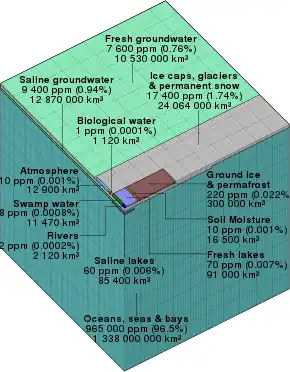Integrated water resources management

Integrated water resources management (IWRM) has been defined by the Global Water Partnership (GWP) as "a process which promotes the coordinated development and management of water, land and related resources, in order to maximize the resultant economic and social welfare in an equitable manner without compromising the sustainability of vital ecosystems".[1]
Development
Discussions on a holistic way of managing water resources began already in the 1950s leading up to the 1977 United Nations Water Conference.[2] The development of IWRM was particularly recommended in the final statement of the ministers at the International Conference on Water and the Environment in 1992 (so called the Dublin principles). This concept aims to promote changes in practices which are considered fundamental to improved water resource management. In the current definition, IWRM rests upon three principles that together act as the overall framework:[3]
- Social equity: ensuring equal access for all users (particularly marginalized and poorer user groups) to an adequate quantity and quality of water necessary to sustain human well-being.
- Economic efficiency: bringing the greatest benefit to the greatest number of users possible with the available financial and water resources.
- Ecological sustainability: requiring that aquatic ecosystems are acknowledged as users and that adequate allocation is made to sustain their natural functioning.
In 2002, the development of IWRM was discussed at the World Summit on Sustainable Development held in Johannesburg, which aimed to encourage the implementation of IWRM at a global level.[4]
IWRM practices depend on context; at the operational level, the challenge is to translate the agreed principles into concrete action.
Implementation
Operationally, IWRM approaches involve applying knowledge from various disciplines as well as the insights from diverse stakeholders to devise and implement efficient, equitable and sustainable solutions to water and development problems. As such, IWRM is a comprehensive, participatory planning and implementation tool for managing and developing water resources in a way that balances social and economic needs, and that ensures the protection of ecosystems for future generations. In addition, in light of contributing the achievement of Sustainable Development goals (SDGs),[5] IWRM has been evolving into more sustainable approach as it considers the Nexus approach, which is a cross-sectoral water resource management. The Nexus approach is based on the recognition that "water, energy and food are closely linked through global and local water, carbon and energy cycles or chains."
Water’s many different uses — for agriculture, for healthy ecosystems, for people and livelihoods — demands coordinated action. An IWRM approach is consequently cross-sectoral, aiming to be an open, flexible process, and bringing all stakeholders to the table to set policy and make sound, balanced decisions in response to specific water challenges faced.
An IWRM approach focuses on three basics and aims at avoiding a fragmented approach of water resources management by considering the following aspects:
- Enabling Environment: A proper enabling environment is essential to both ensure the rights and assets of all stakeholders (individuals as well as public and private sector organizations and companies), and also to protect public assets such as intrinsic environmental values.
- Roles of Institutions: Institutional development is critical to the formulation and implementation of IWRM policies and programmes. Failure to match responsibilities, authority and capacities for action are all major sources of difficulty with implementing IWRM.
- Management Instruments: The management instruments for IWRM are the tools and methods that enable and help decision-makers to make rational and informed choices between alternative actions.
Some of the cross-cutting conditions that are also important to consider when implementing IWRM are:
- Political will and commitment
- Capacity development
- Adequate investment, financial stability and sustainable cost recovery
- Monitoring and evaluation
IWRM should be viewed as a process rather than a one-shot approach - one that is long-term and iterative rather than linear in nature. As a process which seeks to shift water development and management systems from their currently unsustainable forms, IWRM has no fixed beginnings or endings.
Furthermore, there is not one correct administrative model. The art of IWRM lies in selecting, adjusting and applying the right mix of these tools for a given situation.
See also
- Holistic management
- Water resources
- Water resources management
- International trade and water
References
- ↑ "International Decade for Action 'Water for Life' 2005-2015. Focus Areas: Integrated Water Resources Management (IWRM)". www.un.org. Retrieved 2020-11-18.
- ↑ Asit K.B. (2004). Integrated Water Resources Management: A Reassessment, Water International, 29(2), 251
- ↑ "Integrated Water Resources Management: Basic Concepts | IWA Publishing". www.iwapublishing.com. Retrieved 2020-11-18.
- ↑ Ibisch, Ralf B.; Bogardi, Janos J.; Borchardt, Dietrich (2016), Borchardt, Dietrich; Bogardi, Janos J.; Ibisch, Ralf B. (eds.), Integrated Water Resources Management: Concept, Research and Implementation, Cham: Springer International Publishing, pp. 3–32, doi:10.1007/978-3-319-25071-7_1, ISBN 978-3-319-25069-4, retrieved 2020-11-14
- ↑ Hülsmann, Stephan; Ardakanian, Reza, eds. (2018). Managing Water, Soil and Waste Resources to Achieve Sustainable Development Goals. Cham: Springer International Publishing. doi:10.1007/978-3-319-75163-4. ISBN 978-3-319-75162-7. S2CID 135441230.